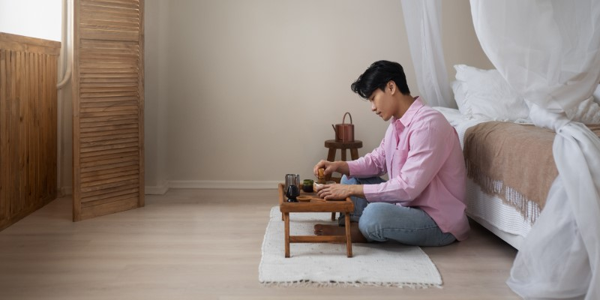The way people approach home, and lifestyle is transforming, with solo living becoming an increasingly popular trend. This shift is driven by changing demographics, cultural shifts, and a growing emphasis on personal independence. Individuals choosing to live alone create spaces that reflect their values, desires, and lifestyle needs. This article will examine how solo living shapes the future of homes, wellness, and personal growth.
The Rise Of Solo Living: Changing Demographics And Cultural Shifts
The trend of solo living has increased over the past few decades and shows no signs of slowing down. Historically, households were primarily composed of families, with single-person homes relatively uncommon. However, this has changed dramatically in recent years. Several factors contribute to this rise, including economic independence, societal acceptance, and shifts in personal priorities.

Demographic Shifts Driving Solo Living
The rise in solo living is driven by changing demographics, including delayed or declining marriage rates, longer life expectancies, and urbanization. In countries like the U.S. and Europe, solo living is shared daily among young adults and retirees, with 28% of U.S. households now single-person. This trend is also growing in Asia, influenced by cultural shifts and economic development.
Cultural Acceptance Of Independence
Culturally, the idea of independence is now celebrated, with many prioritizing personal freedom over traditional family structures. The stigma once attached to living alone has largely disappeared, replaced by a growing recognition of the benefits of self-reliance. This cultural shift empowers individuals, especially women, to pursue solo living as a lifestyle choice rather than a last resort.
Designing Spaces For One: Functional And Minimalist Homes
With the rise of solo living, home designs are adapting to accommodate the specific needs of those living independently. The shift toward minimalist, functional spaces reflects the desire for homes that are easy to maintain, comfortable, and aligned with personal values.
Small Spaces, Big Impact
The rising demand for smaller, efficient homes among solo dwellers reflects the premium on urban real estate. Compact apartments and tiny homes prioritize multifunctional design, featuring fold-out beds, built-in storage, and convertible furniture to maximize space. These choices emphasize practicality and simplicity for single-person households.

The Minimalist Approach
Minimalism has gained popularity among solo dwellers, prioritizing quality over quantity. Embracing fewer possessions and simple furnishings creates a clutter-free, calming environment. Neutral colours and natural light enhance the sense of openness, improving mental clarity and reducing stress in smaller living spaces.
Personalized Spaces
Solo living allows individuals to fully personalize their homes, creating spaces that reflect their personalities, interests, and lifestyles. Without compromising, they can design areas like a creative home office, a relaxing reading nook, or a kitchen tailored to their unique preferences.
Lifestyle Redefined: Independence, Flexibility, And Personal Growth
Solo living is more than just physical space; it represents a broader lifestyle choice that prioritizes independence, flexibility, and self-development. Many individuals living alone see it as an opportunity for personal growth, free from the responsibilities and compromises of shared living arrangements.
Independence And Freedom
One of the most significant advantages of solo living is making decisions independently. Whether it's deciding what time to eat, how to decorate, or where to spend money, solo dwellers enjoy complete autonomy over their daily lives. This level of control can be liberating, allowing individuals to live on their terms without having to consider the preferences or schedules of others.
Flexibility In Lifestyle Choices
Solo living also offers greater flexibility in terms of lifestyle choices. Many solo dwellers can focus more on their careers, hobbies, and personal interests without the distractions or obligations of cohabitation. This flexibility also extends to social lives, with individuals free to cultivate relationships and friendships on their terms. This lifestyle's crucial benefit is the freedom to move, travel, and explore new opportunities without negotiation.
Personal Growth And Self-Discovery
For many, solo living provides an opportunity for self-reflection and personal growth. The quiet and solitude of living alone can foster creativity, introspection, and a deeper understanding of one's needs and desires. Many individuals find that living solo helps them build confidence, resilience, and self-sufficiency. Whether it's learning to cook for oneself, managing finances, or creating a peaceful home environment, the challenges of solo living can lead to significant personal development.

Solo Living And Well-Being: Prioritizing Mental Health And Self-Care
Living alone can also profoundly impact mental health and well-being. While some may worry about loneliness, many individuals who choose solo living find that it allows them to focus more on self-care and mental wellness. By shaping their lives to fit their needs and preferences, solo dwellers can build a lifestyle that nurtures their physical and emotional well-being.
Creating Space For Self-Care
One key benefit of solo living is the ability to design a home environment that supports self-care routines. From setting up a home gym to creating a meditation space, individuals living alone can prioritize their well-being in ways that might not be possible in shared living situations. Solo dwellers often dedicate time to activities that nourish their mental and physical health, such as cooking healthy meals, exercising, and practising mindfulness.
Maintaining Social Connections
While solo living offers independence, maintaining social connections is crucial for well-being. Many people living alone actively work on forming close friendships and participating in social events. The freedom of solo living allows for a balance between social interaction and personal time, which can help mitigate feelings of loneliness. Technology also plays a significant role in keeping solo dwellers connected with loved ones, making it easier than ever to maintain relationships while living alone.

Conclusion
Solo living is more than just a housing trend; it represents a lifestyle prioritizing independence, personal growth, and well-being. As more individuals choose to live alone, home designs, cultural norms, and lifestyle choices are evolving to meet the needs of solo dwellers. Whether through minimalist design, flexible living arrangements, or a focus on mental health, solo living redefines how people approach their homes and lives. This shift reflects a growing emphasis on individuality, freedom, and self-care in an increasingly fast-paced world.


